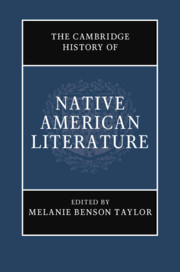30 results
Chapter 12 - Indigeneity
- from Part II - Contexts and Controversies
-
-
- Book:
- The Cambridge Companion to Literature and Animals
- Published online:
- 26 October 2023
- Print publication:
- 09 November 2023, pp 220-235
-
- Chapter
- Export citation
34 - Indigenous Modernism
- from Part III - Situating US Modernism
-
-
- Book:
- The Cambridge History of American Modernism
- Published online:
- 13 July 2023
- Print publication:
- 20 July 2023, pp 573-590
-
- Chapter
- Export citation
Chapter 1 - Fictions of the Native South
-
-
- Book:
- A History of the Literature of the U.S. South
- Published online:
- 29 April 2021
- Print publication:
- 20 May 2021, pp 19-33
-
- Chapter
- Export citation
Indigenous Interruptions in the Anthropocene
-
- Journal:
- PMLA / Publications of the Modern Language Association of America / Volume 136 / Issue 1 / January 2021
- Published online by Cambridge University Press:
- 27 January 2021, pp. 9-16
- Print publication:
- January 2021
-
- Article
-
- You have access
- HTML
- Export citation
Copyright page
-
- Book:
- The Cambridge History of Native American Literature
- Published online:
- 18 September 2020
- Print publication:
- 17 September 2020, pp iv-iv
-
- Chapter
- Export citation
Contents
-
- Book:
- The Cambridge History of Native American Literature
- Published online:
- 18 September 2020
- Print publication:
- 17 September 2020, pp v-viii
-
- Chapter
- Export citation
Part III - Native American Renaissance (Post-1960s)
-
- Book:
- The Cambridge History of Native American Literature
- Published online:
- 18 September 2020
- Print publication:
- 17 September 2020, pp 253-428
-
- Chapter
- Export citation
Part II - Assimilation and Modernity (1879–1967)
-
- Book:
- The Cambridge History of Native American Literature
- Published online:
- 18 September 2020
- Print publication:
- 17 September 2020, pp 129-252
-
- Chapter
- Export citation
Part I - Traces and Removals (Pre-1870s)
-
- Book:
- The Cambridge History of Native American Literature
- Published online:
- 18 September 2020
- Print publication:
- 17 September 2020, pp 15-128
-
- Chapter
- Export citation
Introduction: What Was Native American Literature?
-
-
- Book:
- The Cambridge History of Native American Literature
- Published online:
- 18 September 2020
- Print publication:
- 17 September 2020, pp 1-14
-
- Chapter
- Export citation
Index
-
- Book:
- The Cambridge History of Native American Literature
- Published online:
- 18 September 2020
- Print publication:
- 17 September 2020, pp 531-544
-
- Chapter
- Export citation
Contributors
-
- Book:
- The Cambridge History of Native American Literature
- Published online:
- 18 September 2020
- Print publication:
- 17 September 2020, pp xii-xx
-
- Chapter
- Export citation
Figures
-
- Book:
- The Cambridge History of Native American Literature
- Published online:
- 18 September 2020
- Print publication:
- 17 September 2020, pp ix-xi
-
- Chapter
- Export citation
Part IV - Visions and Revisions: 21st-Century Prospects
-
- Book:
- The Cambridge History of Native American Literature
- Published online:
- 18 September 2020
- Print publication:
- 17 September 2020, pp 429-530
-
- Chapter
- Export citation

The Cambridge History of Native American Literature
-
- Published online:
- 18 September 2020
- Print publication:
- 17 September 2020
Dedication
-
- Book:
- The Indian in American Southern Literature
- Published online:
- 30 June 2020
- Print publication:
- 16 July 2020, pp v-vi
-
- Chapter
- Export citation
Index
-
- Book:
- The Indian in American Southern Literature
- Published online:
- 30 June 2020
- Print publication:
- 16 July 2020, pp 261-270
-
- Chapter
- Export citation
Acknowledgments
-
- Book:
- The Indian in American Southern Literature
- Published online:
- 30 June 2020
- Print publication:
- 16 July 2020, pp ix-x
-
- Chapter
- Export citation
Bibliography
-
- Book:
- The Indian in American Southern Literature
- Published online:
- 30 June 2020
- Print publication:
- 16 July 2020, pp 239-260
-
- Chapter
- Export citation
Chapter 2 - Confederate Spirits
-
- Book:
- The Indian in American Southern Literature
- Published online:
- 30 June 2020
- Print publication:
- 16 July 2020, pp 112-167
-
- Chapter
- Export citation

